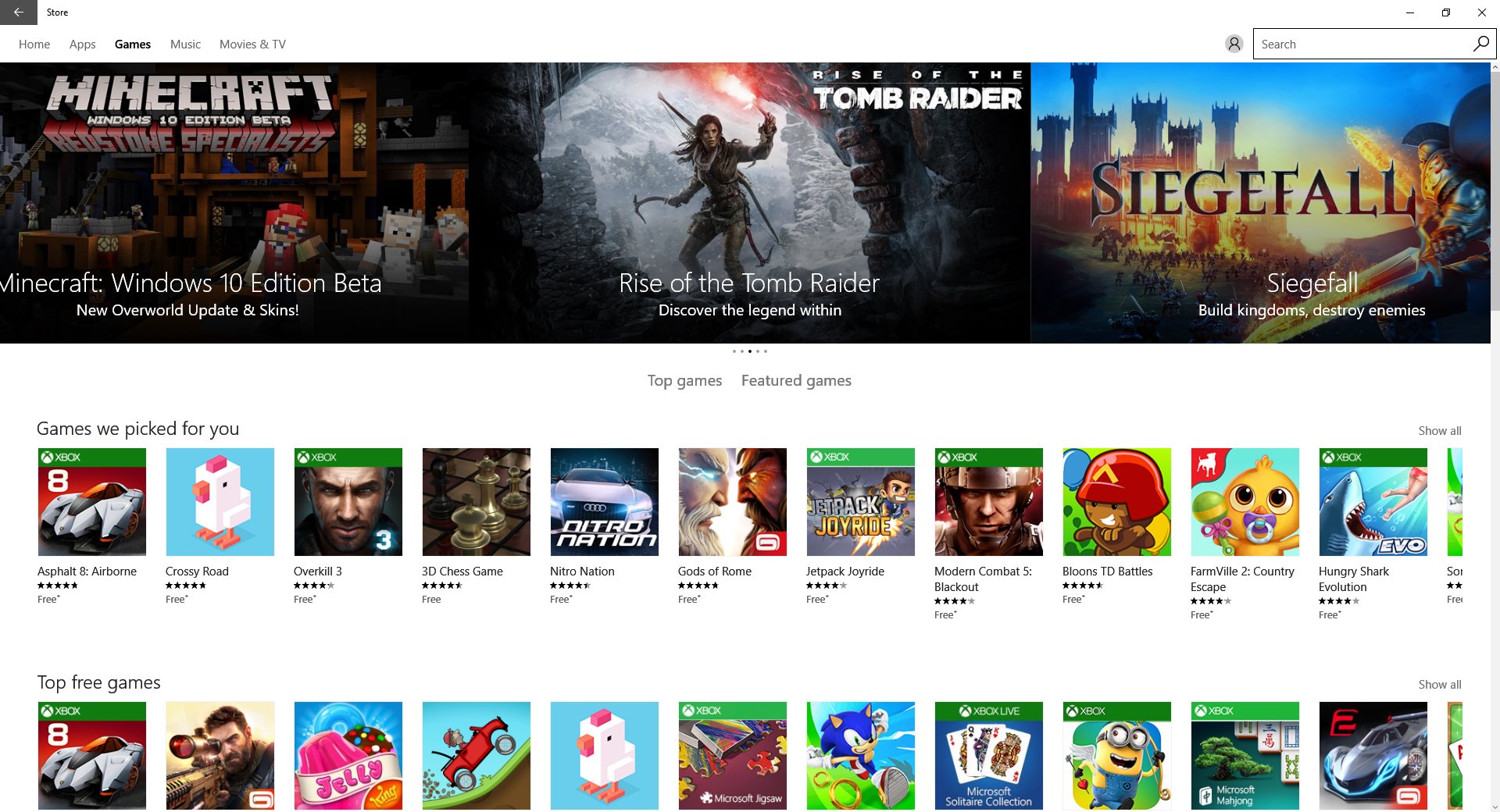The Windows Store: Microsoft's Strategy To Attract PC Gamers
It’s been seven months since Windows 10 became generally available, and with it comes another challenge: attracting PC gamers to the Windows Store. At the Xbox Spring Showcase event, we talked to Mike Ybarra, the director of program management at Xbox, on how the company intends to make the Windows Store a hit with developers and players.
Start From The Bottom
The foundation for any Windows Store app, whether it’s the Netflix app or a brand new game, is the Universal Windows Platform (UWP), which Ybarra called an all-in-one package installation. By using the UWP as the building block for any program, the development process for creators is easier, and the finished product is more stable at launch.
With the utilization of the UWP, the app is considered a Universal Windows App (UWA). We saw the first wave of these UWAs in January 2015, when Microsoft revealed more about Windows 10. Apps such as Office, Mail, Photos and Messaging were all part of this new program. In fact, every game from the Windows Store is considered a UWA.
This new form of development not only helps with getting the games to work on various Windows 10 devices, but it also ensures that the installation process is cleaner.
“We solved the problem where titles could be nested, installed, just put on the registry and everywhere else,” Ybarra said. “One of the problems was I had to format Windows about every six months just to clean it out to get the most performance.” UWA apps don’t have this issue, as all of its files are stored in one location, which should make the uninstallation process easier.
The Vision For UWP And UWAs
Obviously, first-party developers (which are owned by Microsoft) will have their games developed as a UWA. This includes teams such as Remedy, which is currently working on Quantum Break, and Turn 10 Studios, which is working on Forza Motorsport 6: Apex. Both development teams are known for their games on console, but creating a game for the PC is a different challenge.
“When you develop for two platforms, there’s a complexity with that,” Ybarra said. “It takes more dev cost, [and] it’s hard to break even on big games now. UWP is designed to reduce the overall development cost.”
Get Tom's Hardware's best news and in-depth reviews, straight to your inbox.
On top of that, Microsoft also offers some extra hands to assist with development. In addition to providing additional technical support, these reinforcements help developers understand certain aspects of the UWP and its impact on consoles versus PC games. They also provide what Ybarra called “tricks of the trade” in the development process.
Even with Microsoft’s exclusivity on the UWP, Ybarra believes that UWA games created from the platform shouldn’t just be confined to the Windows Store.
“I’m completely open to having UWA sold in more places than our store,” he said. “In fact, that’s a promise of ours to say, ‘If Steam wants to sell a UWA version of a game, go ahead.’ If we had a developer come to us and say, 'I want to make a UWA [game] and I want to distribute it on Steam and Windows,' we’d sit down with them and say, 'Let’s call Valve and figure this out. Let’s make it happen.'"
Even with this spirit of camaraderie, Microsoft still wants people to use its digital storefront to buy more apps for their Windows 10 device. For developers, the Windows Store is another distribution channel, where they can publish their game to an even broader audience than before.
Needs More Work
Even though the Windows Store is up and running, it’s still lacks a few features that PC gamers are accustomed to in various clients such as Steam and GOG. So far, the biggest complaints were regarding the Windows Store overlay and the need for mod support. Ybarra assured us that the company is looking at the issues and figuring out the next logical step for the Windows Store.
Xbox One owners have access to the Game Preview program, which is similar to Steam’s Early Access content. Ybarra said that the company is looking into that feature as well, but there aren’t any concrete plans to bringing the feature to the Windows Store in the near future.
“There’s a lot of complexity when you think about that,” Ybarra said.
Watch It Grow
Just like any new platform, the Windows Store will take time grow. Obviously, people are still sticking to Steam, not only because they’re familiar with the product, but also because it’s been around for quite some time (13 years, to be exact). In that time, Valve’s storefront evolved to its current state. It’s unclear whether it will take the Windows Store five, ten or even fifteen years to reach Steam’s popularity status, but Ybarra doesn’t want people to count it out in its early years.
“Our goal with Windows is to make it easier [and] more reliable for consumers to use. All developers want that target, too, because they get a lot of calls about driver issues or whatever [the case may be],” Ybarra said.
Follow Rexly Peñaflorida II @Heirdeux. Follow us @tomshardware, on Facebook and on Google+.
Rexly Peñaflorida is a freelance writer for Tom's Hardware covering topics such as computer hardware, video games, and general technology news.
-
DrakeFS ReplyWhat about SLI support, or VSync options, or no modding.
MS stated they are working on the V-Sync options and that SLI was up to the game dev to implement it (supposedly nothing is disabling\blocking SLI from Microsoft's side). I have not seen anything from MS addressing the modding concern.
-
poochiepiano I wouldn't mind using Windows store for games. It doesn't matter to me if my library is split up among clients. Might help influence Steam to get back in the game instead of offering "huge" sales where 85% of the games are bad, 14% are old, but good, and the other 1% are new, with modest discounts like 10%. I mean, I still think the sales are good, but not quite like the steam sales I remember.Reply -
amk-aka-Phantom ReplyEven though the Windows Store is up and running, it’s still lacks a few features that PC gamers are accustomed to in various clients such as Steam and GOG. So far, the biggest complaints were regarding the Windows Store overlay and the need for mod support.
This is garbage. Tom's, please elaborate on this, it's not a minor concern. I know from news on other sites that it's not just a "few missing features": gamers are locked out of changing critical settings, for example V-Sync or forcing fullscreen mode instead of borderless windowed. You can't use any overlays, you don't have access to the game's executable (so you can't add it to Steam or use a Steam controller with it), mouse macros don't work. Also, the games are only usable under Windows 10, and the refund policy is pretty much non-existent. Steam needs a kick in its collective behind for sure (they still don't have high DPI support, and even their site still uses Flash for some things that don't need it), but this is just laughable. This is worse than UPlay. This is the accursed GFWL back in new form, and we as PC gamers need to collectively ignore it and spread the word so that our less knowledgeable friends do too. Don't give MS your money for this junk! -
clonazepam Preach it amk-aka-Phantom. I'm a DualShock 4 controller user, so their xbox app and microsoft store is completely useless to me.Reply
Their introduction of xinput was all fine and dandy when they had the install base advantage. Now that's not the case, and they also have the inferior software and inferior hardware, as well as being out sold nearly 2 to 1.
I just assumed it would be bad, but if what you say is accurate, that's absolutely horrible.
My computer is an extension of my own brain, and I would like to have as much control (choice) as possible as to how I conduct my thinking. I don't want to be coerced into thinking a certain way. I don't want to be told my way of thinking is wrong and unacceptable. I may want to think faster (or slower) than others, and the extension of my own brain should be able to accommodate that level of choice. -
realnoize I don't know what's happening at Microsoft. I mean, really, surely, someone at Microsoft knows about Steam and the fact that it has MILLIONS of active users. So Valve, for all the wrongs they can do, must at least do some things right, right? It looks like the Microsoft people behind this are completely ignorant about what PC gamers want, or even who they are and the reasons why they prefer gaming on PCs rather than on consoles.Reply
PC is about CHOICE. It's about OPTIONS. It's about CUSTOMIZATION. Let the user choose what he likes best. What works best for him and his hardware.
Universal apps/games with no adjustable settings are fine for phones and tablets. Or consoles. Not for PC.
"Yeah, but what about those 'casual' players on PC that don't want to deal with all of this?" some might say... Well, those people surely aren't going to buy Gears of War. They're playing Solitaire, Wordament or other mobile-type games. And most of those gamers who don't want to set anything up before playing are ALREADY playing on consoles.
I don't understand who Microsoft is targeting with this. -
porksmuggler GFWL 2.0, The Walled Garden Returns. Can't blame them for trying, nice puff piece by the way, like the softball "Needs More Work" section.Reply -
Gam3r01 There comes a point in nearly everything when you are too far along to try and change anything.Reply
Steam has already flooded the market and secured its place at the top. MS may have had the right idea many years ago, but this seems like a futile effort. -
epobirs Try to explain to the customers targeted by the Windows Store why V-sync, SLI, and modding is an issue. You'll get a blank stare and perhaps hear, "I just want to play." These people are not going to care about the glories of gaming on a high-spec rig. They'll play 60fps at 4K when it works on their $800 AIO from Best Buy and only if it happens by default.Reply
All those things you may think should matter are just noise to them. Trying to make them care is like trying to insist that somebody who wanted the slightly peppier model of car needs to subscribe to Street Racer magazine to achieve fulfillment. Microsoft knows there are tens of millions of people who are not going to buy a game console but will buy games if they don't have to blatantly advertise the activity to casual observers in their home. Yes, after all these years there are still plenty of people who regard overt indications of gaming as a mark of immaturity. Those people have money to spend. -
Noah_11 I think people are missing the point in Microsoft's strategy. They're not trying to compete with steam. They are trying to bring Xbox gamers to the PC. Why? So they can sell them on windows software and services. This is good for PC gaming.Reply

